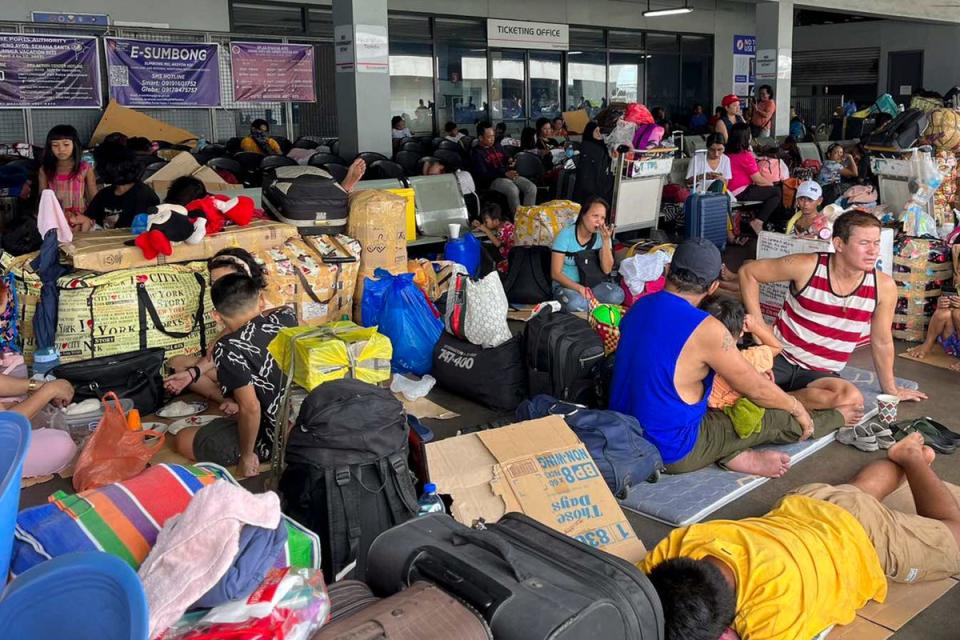Typhoon Doksuri heads towards China and Taiwan after causing widespread destruction in Philippines
Powerful typhoon Doksuri is heading towards Taiwan and China after striking northern Philippines and causing widespread destruction with its ferocious wind and rain while leaving tens of thousands displaced.
Two of Taiwan’s largest cities shut down schools and offices on Thursday as the typhoon brought heavy rains and winds to the island’s eastern and southern coast.
Doksuri weakened further on Thursday, with sustained winds of 155kph and gusts of up to 190kph, according to Taiwan’s Central Weather Bureau.
The typhoon’s centre will not hit Taiwan’s mainland, but its outlying bands will still bring stronger winds and rains on Thursday afternoon.
In the south, port city Kaohsiung and the ancient capital Tainan announced that offices and schools will be closed on Thursday. Hualien and Taitung counties in the east have also shuttered schools and offices. Kaohsuing also evacuated some 300 residents who lived in a mountainous part of the district, according to the semi-official Central News Agency.
On Wednesday, the powerful storm made landfall in the northern island of Philippines, blowing off tin roofs, knocking out power lines, flooding low-lying villages and leaving nearly 16,000 villagers displaced.
The typhoon’s initial impact was felt on Fuga Island off Aparri town in Cagayan province, where authorities had evacuated 15,843 people from high-risk coastal areas.
Schools and workplaces were ordered to shut down on Tuesday as typhoon Doksuri approached the region.
One person was killed and two others injured in the northern and central regions of Calabarzon and the Western Visayas region.
The wide band of wind and rain, stretching 700km, affected thousands of people in other northern provinces as well, compounding the displacement and damage.
By Wednesday morning, the typhoon was blowing over the coastal waters of the Babuyan Islands in Luzon Strait, off Aparri town, said forecasters.
“Our northern coastal towns are being battered,” Cagayan governor Manuel Mamba told the Associated Press. “I’m receiving reports of tin roofs being blown away and flooding that could not drain out probably because of tidal surges coming in from the sea.”
Doksuri, while slightly weakened after landfall, still maintains its dangerous status, with sustained winds of 175km/h and gusts of up to 240km/h.
The full extent of the damage will be assessed after the typhoon subsides, but there are fears of significant harm to Cagayan Valley’s corn and rice farms, already affected by a months-long dry spell before Doksuri’s arrival.
Initial reports indicated at least four towns lost power due to the typhoon, and six bridges became impassable due to flooding.
An advisory from the country’s weather bureau warned that “violent, life-threatening conditions are expected to continue” on Wednesday over northwestern Cagayan, the outlying Babuyan Islands and the northern mountainous regions of Apayao and Ilocos Norte provinces.

Transportation services were heavily affected, with more than 3,700 inter-island ferry passengers and cargo truck drivers stranded, along with nearly 100 passenger and cargo vessels and motor bancas, as a no-sail order was imposed by the Philippine coastguard.
Typhoon Doksuri’s impact has also been felt in central and northern provinces, including in metropolitan Manila, where seasonal monsoon rains were intensified.
The typhoon is expected to move away from the northern Philippines on Thursday and head northwestwards, grazing past Taiwan’s southwestern coast before making landfall in southeastern China later this week.
The storm will travel through the Taiwan Strait during the day on Thursday and make landfall in China’s Fujian province on Friday.
The Philippines is the most typhoon-prone country in the world as it is located just above the Equator and faces the western Pacific, with little else to absorb the energy of storms before they hit land.
Scientists said tropical storms, which are fuelled by the warm, tropical waters, are becoming stronger and more frequent due to the climate crisis, making countries like the Philippines, which already face around 20 typhoons each year, more vulnerable.
Recently, typhoon Mawar, locally known as Betty, also battered through the country, devastating the northern islands.
Additional reporting by agencies

